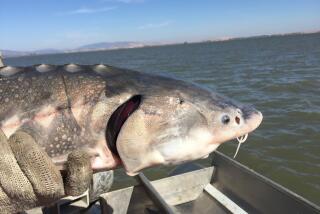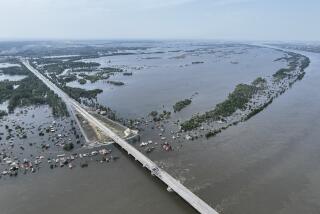Poachers Target Caviar Industry, Rival Claims : Russia: Harvest of sturgeon and eggs they carry is down for everyone except for thieves, who take nearly one of every 10 fish pulled from the Volga.
- Share via
ON THE VOLGA RIVER DELTA, Russia — There is a saying among fishermen who live along this stretch of the Volga near the Caspian Sea: The bread can be white or brown, but the caviar must be black.
When there is no more bread for sandwiches, they swallow their caviar by the spoonful, scooping it from metal bowls that hold more than could be had in a month of Manhattan cocktail parties.
Heaping bowls of beluga and sevruga belie the reality of the catch: The harvest of sturgeon and the valuable eggs they carry is down for everyone except increasingly bold poachers who take nearly one of every 10 fish pulled from the river.
Volga sturgeon face other hazards as well: pollutants dumped into the river by cities and farms along its 2,300-mile route, low water levels caused by the many dams, and the latest threat--politics.
The breakup of the Soviet Union shattered the caviar cartel that Moscow and Tehran forged over decades to protect the industry and maintain high prices in the West.
Iran and the Soviet Union once had exclusive access to the Caspian, home to about 90% of the world’s sturgeon, which wend their way up the Volga to spawn.
Now, the Caspian is ringed by Iran, Russia, Azerbaijan, Turkmenistan and Kazakhstan, each hungry for the hard currency that caviar fetches.
Turkmenistan demanded 25% of this year’s 10,000-ton catch, arguing that it has one-quarter of the Caspian shoreline. Russia objected, noting that most of the fish are hatched and spawn in Russian waters.
Suddenly, no one is satisfied with the old limits devised by Soviet authorities.
“Back then, none of the republics ever asked for more than they were allotted because whatever they produced went to the central government, not the republics,” said Vladimir Ivanov, director of the Caspian Fishery Research Institute upstream in Astrakhan, southern Russia.
“Now, the situation has changed because everyone wants to catch more fish,” said Ivanov, whose institute helps set the seasonal limits and is caught in the middle.
The collapse of Soviet power also has meant open season for poachers. Like criminals ashore, they find it easy these days to evade law-enforcement authorities.
Some, unwilling to wait the 15 to 18 years it takes a sturgeon to mature and spawn, cast their nets in the sea, catching young and mature fish alike. Others drape nets across narrow points in the river and catch so many fish that they simply take the eggs, leaving the huge sturgeon to rot on the bank.
Much of the poachers’ caviar ends up in the private markets of Moscow, where it sells for about $15 a pound. In the West, high-quality caviar can go for $50 an ounce.
The problems and politics of the caviar industry seem distant at dawn on the Volga, where fishermen in orange hip-waders patiently spread their nets from dinghies they pole toward the center of the river.
Unfurling the huge net in the swift river is an art, and the men perform it every 40 minutes in their 16-hour working day.
When the net is fully extended, they pull in the catch: 5-foot-long sturgeon and an assortment of smaller fish that are hurled ashore, where they flop on the muddy bank until the men gather them up and take them to a processing ship.
The bulging nets and the smoked sturgeon and black caviar seen at breakfast lunch and dinner paint a portrait of plenty, except to the eye of a fisherman.
“This is the worst catch I’ve seen in five years,” said Slava Ostroukhov, 26, taking a break in one of the 40 small fishing camps set among the delta’s thick, swaying reeds.
When asked whether the catch would be better next year, he said, “I’m not an optimist.”
Ivanov of the research institute, an authority on the Volga and its fish, understands that kind of pessimism. Both fishermen and sturgeon, he said, have paid the price for devastating pollution during the 1970s and the lowest water levels on the Caspian in 400 years.
“They speak about those years for the sturgeon in terms of a war for a human being,” Ivanov said, fighting a small battle of his own with a cloud of mosquitoes hovering at the bow of his boat.
He confirmed Ostroukhov’s observation: The sturgeon catch has been slipping for a decade. But conditions have been improving at the same time, with the Caspian water level making great gains since 1985.
Even so, Ivanov said the fishing probably will not pick up much until the end of the decade because sturgeon spawn so late.
One hopeful sign: Fishermen already see greater numbers of the other fish long used as a barometer of the sturgeon’s well-being, Ivanov said. The catch of these fish has doubled since 1980.
As for poachers, Ivanov would like to make them legitimate.
“Poachers are a social evil,” he said, “but I take a slightly different view. In the long run, the fish they catch still go to the people. If there is no state monopoly, then everyone is free to catch fish.
“The solution we’re trying to put forward is to prepare licenses and turn poachers into licensed fishermen.”
More to Read
Sign up for Essential California
The most important California stories and recommendations in your inbox every morning.
You may occasionally receive promotional content from the Los Angeles Times.













